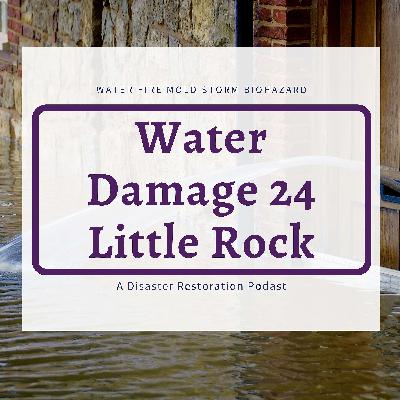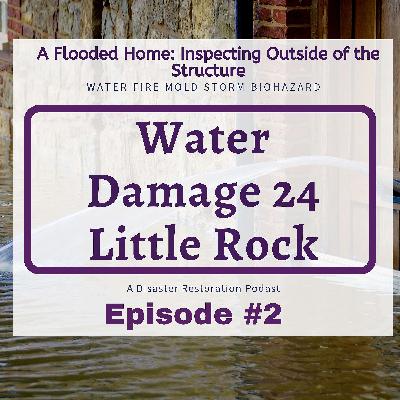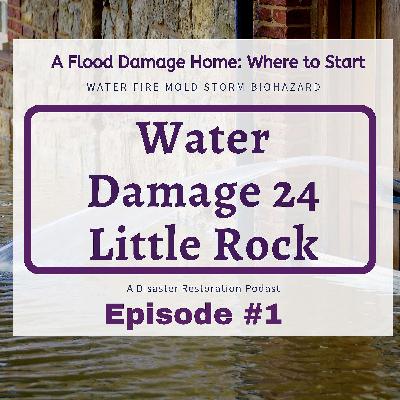Discover Water Damage 24 Little Rock
Water Damage 24 Little Rock

Water Damage 24 Little Rock
Author: Water Damage 24 Little Rock
Subscribed: 1Played: 5Subscribe
Share
© Water Damage 24 Little Rock 2020
Description
Water Damage 24 Little Rock is a podcast about practical advice, tips, and training from disaster restoration experts. This podcast is intended to Water Damage 24 Little Rock combine ideas about restoration work and will inform listeners about much different water damage encounters faced in the field. The tips and the information shared in this podcast will help increase your knowledge and the view of all the restoration aspects in general. Water Damage 24 Little Rock is a network of contractors who offer solutions to disasters such as water damage, fire damage, mold hazards, natural disasters, and more. To learn more visit our website and contact us anytime.
4 Episodes
Reverse
During a flood cleanup, the indoor air quality in a home office or other type of building may appear to be the least of one's problems. However, failure to remove contaminated materials and to reduce moisture and humidity can present serious long-term health risks standing water and wet materials are a breeding ground for microorganisms such as viruses, bacteria, and mold. Many of these contaminants can become airborne and be inhaled causing disease triggered in allergic reactions and continue to damage materials. Long after the flood, if flood water contains sewage or decaying animal, carcasses, and infectious disease is a major concern even when flooding is due to rainwater, the growth of microorganisms can cause allergic reactions and other conditions and sensitive individuals. For these, health reasons and to lessen structural damage, and all standing water should be removed as quickly as it is safe to do so excessive moisture in a structure. After a flood is an indoor, air quality concern for a number of reasons including any microorganisms brought into a building during flooding and water damage may present the health hazard and these organisms can penetrate deep into soaked porous materials and later be released into the air or water high humidity and moist materials provide ideal environments and for the excessive growth of microorganisms that were already present in the home and before the flood.In addition, long-term increases in humidity in a building can also foster the growth of dust mites dust. Mites are a major cause of allergic reactions and asthma the drying out process can take time in the growth of microorganisms and will continue as long as there is moisture or the humidity is high. Some materials tend to absorb and keep water more than others. In general, the materials that are wet and cannot be thoroughly water cleaned and dried within 24to 48 hours may need to be discarded as they can remain a source of microbial growth. If the building is not dried out properly a musty odor signifying growth of microorganisms can remain. After the flood during the cleanup, their area number of additional concerns people need to be aware of these include everything from electrical hazards to exposure to lead dust and asbestos. Among others, these are just a few things to know about flood cleanup and indoor air quality. To learn more about this or other IAQ health and safety and environmental issues please visit the website shown on the screen.
Nine emergency tips for water damage cleanup. When you have flood damage from flooding or leaks every minute counts and you can count on the immediate response that only SERVPRO can provide, here are nine emergency tips for water damage cleanup situations. What you can do until help arrives number one, be careful entering buildings make sure the electrical power is off and the structure is sound, before entering and inspecting a water-damaged building. Number two, wear protection. Wear an organic vapor respirator available from paint or building supply stores along with rubber gloves eye protection and protective clothing. Number three, know what to throw away. Don't try to restore porous items that contain contaminated flood water in most cases throw out any wet drywall carpeting, carpet pads, mattresses, pillows, box springs, and particleboard. Remember that all items must be documented before being thrown away. Number four, try to save wet clothing and household fabrics. Clothing and fabrics like drapes can be salvageable. Number five, open pockets of saturation look behind areas where water has probably entered, remove base moldings and portions of damaged walls and wet installation, and locate the waterline and measure 15 inches to 20 inches above it. Everything below that line should be removed and discarded. Number 6, clean aggressively. Clean wall cavities and expose durable materials like studs and joists by pressure washing with detergent solutions, be sure to disinfect and clean up the water damaged all affected areas including walls wood and non-upholstered furniture that sat in the water. Number 7 prevent mold growth. You may not see it at first but mold will appear in a few days. Mold thrives in moist an environment with organic material like paper or particleboard and within temperatures between 68 degrees Fahrenheit and 86 degrees Fahrenheit. To keep mold from growing and mold remediation to keep the air moving and maintain moderate temperatures as much as possible. Number 8, dry out before you rebuild. To prevent dry rot and on-going structural damage don't reconstruct over covered wood materials until the moisture content falls below 16% and make sure you add an antimicrobial before the walls are closed up. Number 9, consider hiring a professional. We're here to help the team at servpro have specialized water damage cleanup training and experience to quickly clean and restore your commercial building home or property. We realize that unexpected flooding or leaks are stressful for you and your family. Let us help you restore your property quickly and easily. Servpro water damage cleanup, like it never even happened.
It's important when you first come to the house, that you haven't been. Yet, you do a full walk around all the way outside of the entire house and look for Water Damage 24: check out our water damage contractors in Arkansas, AR to the house. This one looks fine when we first come up to it but as we first inspect it, we didn't have this fire line tape. Here, we noticed that the entire foundation behind these bushes is caved in and from this corner. All the way around the corner, we walk around and we'll see more damage, this saves and this house is not structurally safe to go into. As we walk around, over this corner this porch you can't see underneath it, but that foundation has gone underneath, so that porch and his essence floating up above. There the supports might be gone from that porch too. Then over here, you can see straight through that water damaged house and you need to make sure and do that walk around first thing. The other thing to do is when you do the walk-around of the house and to look for the warning labels. It might be on the windows and doors and you'll have to look around. It depends on the type of the house and where they're going to post these. For example, here the gas utility company has posted a warning about what's done, and with the information that you need including phone numbers, you can contact them as well as the electric company. What they've done and contact phone numbers included and also the city fire department has come through. In this particular house, the label in this house is unsafe to enter because of foundation issues on the outside and that is another thing we want to look at.Now, we've already looked at this porch to make sure we've looked underneath around and to make sure it's solid and where to find water damage repair in Arkansas. For example, like this glass door that's have caved in here and the homeowner might be tempted to walk into that glass, but easily one of these big shards of glass you'd come and just slice down anywhere on them, just absolutely no way. You want to go in through and these kinds of water removal and water cleanups we are doing in Little Rock. The initial walk around and the thing we want to look forward to is to make sure the gas is off. If there's gas service to the house and as well as electricity. In this case, you can see that the water damage 24 little rock company's been here and where they've capped off. They've actually pulled the meter and in this case, that won't always happen, but they've capped off the gas line coming in and they've shut it off and sealed it to make sure it can't be turned back on and to make sure that valve is shut off.
When you first enter a flooded water dam and you want to try to prioritize the work and you have a lot of contents and things that were left behind, try to get those things out of the way first, because when you start doing the deconstruction and taking down the walls, those are just going to get in the way, so that's probably the first thing. Next, if you have a carpet and you wanted to take out the water, again that can be done with a utility knife. Cut it up into pieces so they're not too and not too heavy to carry. Take out the water-containing material like that because they can contribute to the mold problem. The next thing is really looking at the different levels of the house. In this case, again this is the water level about five and a half feet where the water got to on the main floor, so the basement was totally submerged and the upstairs by and large was okay. We did take out some of the carpets on the steps to and just above the level of the water. Other than that, the upstairs is basically pretty good shape, so we can talk about this in terms of triage. Almost like the medical term, we talked about patients and different conditions. During this kind of crisis and emergency situation, that's really what we're looking at. Here is our basement, it is really the patient that is going to be in the worst shape but there's really not a whole lot you can do immediately to help them. The priority, in this case, is on the main floorgoing. Trying to get out as much of the wall, so that the studs and the interior walls can dry out so that the mold growth doesn't take over the upstairs as we talked about. As the general health of the three patients, a little bit of work but really the only thing we did was take out some of the carpets on the stairs and within that, we could prioritize even further and start with the main floor and getting the contents out and taking the carpet out. Looking at the rooms, the bathroom is a wet environment and normally the most mold that we typically see at the beginning is in the bathroom. We where to locate the very best basement water removal in Arkansas and tried to prioritize by going to the bath first, then we walk over to the kitchen. Here's our kitchen area and through here is our second priority because of the wetness and again, in the kitchen, we need to get things out of the kitchen as well. The next priority that would be the external walls and generally on theexternal walls, you can see here maybe back over here is probably the best shot theater insulation on the exterior walls. Again, this is an old house so it's got old insulation but that insulation sucks up the moisture and folds it against the wall and it creates an ideal environment for mold organisms to grow, to cause damage, and for mold remediation. Also, I have a health concern and that's probably the next priorities. The exterior walls getting and those exposed pulling out the insulation and trying to get things dried out. If you look at some of the windows and here we've got fans propped up and once you get everything stripped out and ventilation is critical to keeping the environment dry. Now, one of the things that we saw as we talked a little bit about mold already and if you look in the kitchen, here you can see some laughs that still remain. Going for the upstairs is the other side of the wall to the upstairs and you can see the type of mold that grows under. These type of conditions again the waterline and it was about right here but you can see and I'll hide the mold climbs above that water on, so it's not sufficient just to remove the wall to the water damage and you have to go all the way up and probably go at least a foot above. The top part where it pulls water damage cleanup through and there's no more mold. Again, ventilation is key and located throughout the house and this structure is fairly well open so there's a lot of ventilation and that'll help with the out process.







